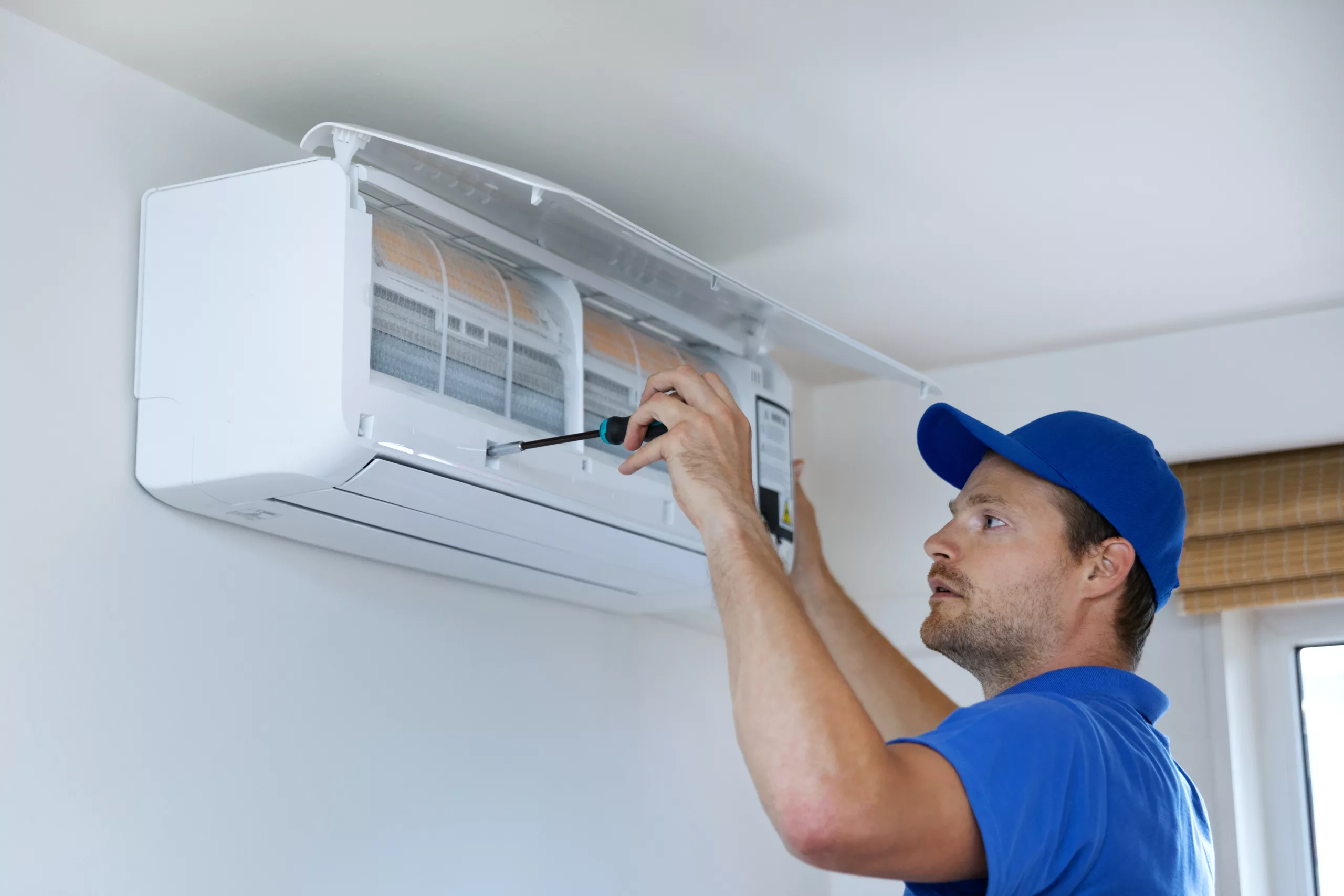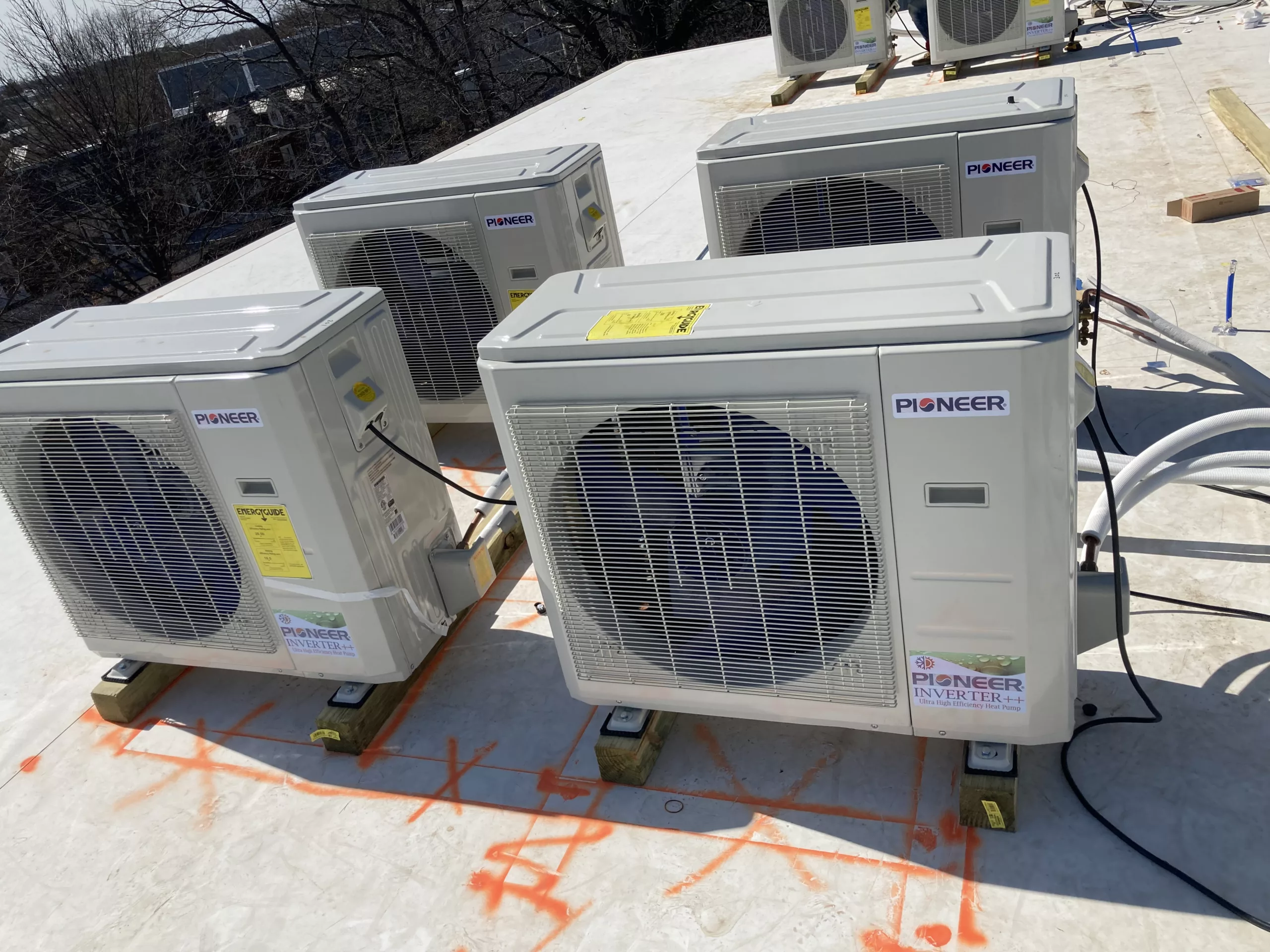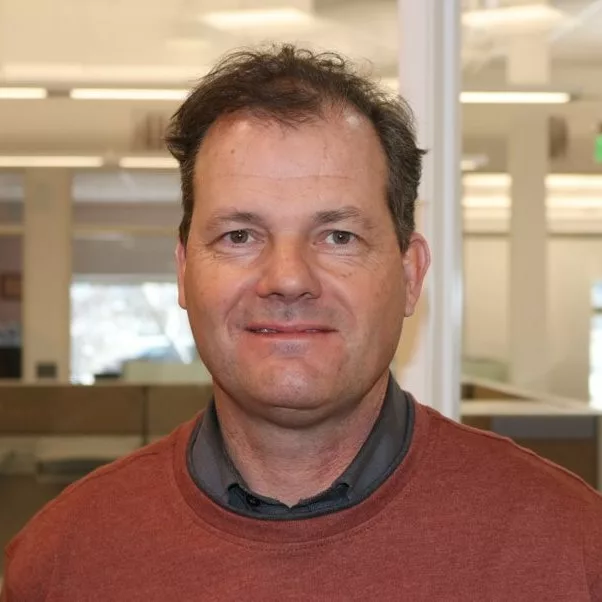
Originally published in the Association Energy Services Professionals’ (AESP) Energy Intel Magazine (https://pubhtml5.com/sicr/vayi), June 2022 — Air-source heat pumps (ASHPs) are an increasingly important tool in energy efficiency programs, as they can be several times more efficient than conventional systems for space heating and cooling such as furnaces, boilers, and central air conditioners. Heat pumps aren’t new; the technology has been around for decades, and they are a popular heating appliance in milder climates in the U.S. However, recent technological innovations, such as inverter-driven compressors, have dramatically improved their performance and efficiency. Modern ASHPs can serve as a highly efficient space heating solution even in very cold climates, performing well below 0°F depending on the equipment. Terms for this class of equipment run the gamut of HVAC jargon, but I will refer to them here as cold-climate air-source heat pumps (ccASHPs).
Industry leaders, regulators, and policymakers are beginning to recognize the value of these systems, evidenced by new policies and programs to increase heat pump adoption. State programs to encourage replacement of conventional HVAC systems with high-efficiency heat pumps (including ccASHPs) in residential and commercial buildings have been growing, primarily in the West Coast and Northeast. The U.S. Department of Energy (DOE) recently launched the residential Cold Climate Heat Pump Challenge, which will leverage partnerships with manufacturers and utilities, among others, to advance deployment of these technologies.
Lights are turning green, but there’s a link in the chain that needs some attention: HVAC contractors.
Defining the Need
A Changing Landscape
Across the U.S., state policymakers are intensifying clean energy development efforts and increasing energy efficiency investments. New laws have been passed that advance decarbonization and electrification, several of which (such as Minnesota’s Energy Conservation and Optimization Act) promote clean heating by incentivizing fuel switching. Some states are advancing more-efficient building energy codes: the list of states that have adopted the 2018 International Energy Conservation Code (IECC) is growing longer and many states are now reviewing the new 2021 IECC. Further, the District of Columbia and multiple states adopted water- and energy-saving standards for various appliances. Innovative green solutions like ccASHPs will have a vital role to play in efforts to slash carbon emissions and phase out inefficient equipment.
The Next Thing in Green: Cold-Climate Air-Source Heat Pumps
ccASHPs have a range of applications for residential and commercial buildings, in both new construction and retrofits. They can be installed in all U.S. climate zones and provide year-round space conditioning, often without backup heating. Their high efficiencies enable them to drive deep energy savings; for example, a field assessment conducted in Minnesota showed that ccASHPs achieved site energy reductions between 37% and 54%. Because they provide both heating and cooling, ccASHPs can often remove the need for multiple systems for space conditioning. They can also be connected to smart controls like smart thermostats, giving both utilities and end-users greater control in managing energy demand. It’s also worth noting that ccASHPs increase customer comfort by providing better control over temperature set points, improving air quality, and dehumidifying customers’ homes.
Where Are the Contractors?
Finding contractors willing or able to sell, design, install, and maintain ccASHPs has been a challenge for utilities and their energy efficiency program implementers. Energy leaders throughout the country have determined that there are too few training opportunities to help contractors embrace and advance this new technology. The need was recently illustrated on a national level when the U.S. DOE’s Building Technologies Office awarded approximately $83 million to support, among other things, the development of heat pump education and training programs for contractors. Advanced trainings can address both unfamiliarity and outright resistance which, though they overlap, represent distinct needs and concerns, and contribute to a cycle of aversion to ccASHPs.
Examining the Barriers
Not Your Grandparents’ Heat Pump
Contractors often confuse ccASHPs with previous generations of heat pumps, which underperformed in cold climates and discouraged customers. Often, they did not adequately heat homes, and when they were heating the space, the way they operated confused customers. Heat pumps blow cooler air than gas-fired, forced-air systems or electric resistance heating—typically at 85°-95°F, in stark contrast to the 130-140°F+ air common to the existing, conventional heating systems. This difference created the impression that the heat pumps weren’t working even when they were functioning as intended. Over time, customers’ negative experiences made contractors wary of promoting and installing these systems; contractors are very risk-averse when it comes to their businesses and follow-up service needs impact their profits. Many contractors started adding risk premiums to installation of this type of equipment, further impeding the technology’s growth. Ultimately, they became as, if not more, resistant to heat pumps than the customers.
Change Happens Slowly
Contractors typically promote and install systems they know and trust, and they may resist new technologies despite their benefits for customers. Many contractors are frustrated by continuously having to incorporate new technologies into their business models. Many are more interested in providing an uncomplicated service than they are in promoting or upselling equipment that can be difficult to explain to the customer and more challenging to install. In market research conducted by the Center for Energy and Environment (CEE), which leveraged focus group data and a survey, HVAC contractors in Wisconsin noted that educating customers on ccASHPs could be a challenge and require significant time. Some of the contractors indicated that they primarily sell heat pumps when customers ask for them. Customer awareness of heat pumps (especially ccASHPs) is nascent in most regions, and customers have their own biases towards the familiar. The resulting catch-22 means that opportunities for ccASHP installations are left on the table.
Customer Satisfaction and Keeping Energy Costs Low
Contractors pay close attention to heating costs incurred with different energy sources, and historically, gas is significantly less expensive than electricity. While there is ample data to show that implementing all-electric designs is less expensive in the new construction market, as the properties do not require gas infrastructure (pipes, meters, etc.), fuel switch upgrades in the retrofit market can drive up consumers’ energy costs depending on factors such as climate and utility rates.

This barrier can be mitigated by leveraging ccASHPs in holistic retrofits that incorporate other energy efficiency measures, e.g., LED lighting, air and duct sealing, better windows, etc., and perhaps PV solar installations. However, this approach will often require the HVAC contractor to become (or engage) a whole-building retrofit general contractor so that the building shell is addressed at the same time as the HVAC. Further, HVAC contractors cannot ultimately be the sole driver for this solution; it depends on other factors including building owners’ financial capacity and the utilities’ energy efficiency program design (i.e., available rebates, eligible measures in the technical resource manual, etc.). A fuel switch can also require upgrades to the electrical infrastructure. If the contractor recognizes that need—which doesn’t always happen—it can be challenging to advocate for those upgrades with customers because they are often very costly. While some utilities such as Sacramento Municipal Utility District have begun incentivizing infrastructure upgrades, those utilities are the exception.
Inexperience with Heat Pump Systems
Heat pumps’ market share is relatively low, and this is especially true for ccASHPs. In most regions, contractors are largely unaware of their applicability in different installation scenarios and climates. There are some resources available to contractors such as manufacturer trainings and online guides and workshops provided by energy efficiency programs. However, when contractors don’t take advantage of these opportunities (whether due to unwillingness or ignorance), they can make uninformed recommendations to customers or deliver faulty installations.
Retrofits can present distinct challenges and more opportunities for inexperience to create problems. Contractors may recommend ccASHP equipment sizes based on apartment square footage, capacity of the old equipment, or their previous experience, rather than conducting comprehensive energy audits or using recommended HVAC sizing resources such as Manual J calculations. In deeper retrofits where multiple energy efficiency measures are used, contractors can easily fail to account for efficiency improvements in the building shell and, consequently, oversize the equipment. If the upgrade is a fuel switch, contractors may not fully understand—or be able to articulate to customers—the necessary upgrades to the electrical infrastructure, the associated costs, and long-term benefits that can offset upfront costs (reduced operational costs over the long term, etc.).
Evaluations from several states found that when heat pumps were not designed and operated properly, they achieved lower-than-anticipated energy savings. Contractors get call-backs when customers have problems with the equipment, and because they may not understand that the failings were with the installation and not the technology, we could ultimately see a recreation of the pattern the industry experienced with first-generation heat pumps.
Where Do We Go from Here?
Addressing the barriers
Informed by its engagement with contractors, the CEE recommended that materials and training focus on energy costs, switchover temperature, system design and sizing, system selection, and proper installation. Further, they noted that while most of the contractors involved in the research had attended manufacturer trainings (primarily Mitsubishi trainings), those trainings typically lack details that help contractors sell the technology to customers, instead focusing on technology performance. 
Effective trainings will need to provide comprehensive education, on-the-job training, and supplementary resources to support ccASHP installations in both the new construction and retrofit markets. To ensure contractors are equipped to tackle the complexities inherent in retrofits, trainings will also need cover the conversion of various HVAC systems and fuel switch upgrades, the need for any added penetrations to the building envelope, and of course—proper sizing. Such experience will expand the services contractors can provide post-training and enhance their value proposition with future customers. Contractors need sufficient understanding to take the necessary steps, whether through collaboration or additional education and certification, to develop and implement scopes of work that leverage all measures necessary to maximize energy savings and reduce energy costs. To reinforce and expand the talent pool, trainings will need to target both current contractors and entry-level workers.
Northeast Energy Efficiency Partnerships (NEEP) offered specific training recommendations which, though developed as part of a regional initiative, are widely applicable. They recommend trainings include information on how the technology works and important differences from older ASHPs. Trainings should also leverage existing installer best practice resources, some of which NEEP has developed. Further, messaging in the trainings should be tailored to resonate with specific stakeholders; for example, with traditional HVAC contractors, they recommend: “ASHPs offer a cooling solution, especially well-suited for homes that heat with hydronic systems, as well as a highly efficient heating solution to customers.” For fossil-fuel heating system installers, they recommend: “Inverter-driven ASHPs provide an attractive additional product offering that is relatively easy to install, offers cost savings opportunities to [installers’] customers and can keep work force busy year-round.” Such messaging requires adaptation for different contexts, but it’s worth noting that NEEP’s efforts have achieved some measurable success since their inception.
In the Works and Next Steps
In some parts of the country, heat pump training for contractors has been integrated into decarbonization or heat pump deployment efforts. For example, the City and County of Denver’s Office of Climate Action, Sustainability, and Resiliency recently awarded funding to launch the Denver Clean Energy Construction Career Accelerator, which will help HVAC contractors learn to install and maintain ccASHPs via on-the-job training at affordable housing retrofit sites. The Mass Save program in Massachusetts offers training that includes courses on ccASHPs’ capabilities, performance, and comfort, as well as weatherization and effectively selling ccASHPs. The New York State Clean Heat Program requires new ASHP installers seeking to become participating contractors to receive manufacturer-sponsored ccASHP trainings, and provides numerous online resources to support successful installations.
As we move forward, energy efficiency industry leaders such as utilities and their program implementers can help close the skills gap. By coordinating resources and expertise with key stakeholders such as HVAC associations, governments, and local workforce development programs, they can support the growth of an HVAC workforce that can design, install, and maintain advanced heat pump technology.
 Robert Foley is the Technical Solutions Specialist at ICAST (International Center for Appropriate and Sustainable Technology), a nonprofit that delivers energy efficiency upgrades to multifamily homes. A veteran in the clean energy space, he currently provides clean energy workforce training as part of ICAST’s programs and has trained hundreds of individuals. He also conducts energy audits and modeling and assists in program and custom incentive design. His credentials include HVAC contractor’s licenses in New Mexico (MM98) and the City of Denver; general contractor licenses in Utah (B100), New Mexico (GB98), and California; and NATE and BPI Building Analyst certifications.
Robert Foley is the Technical Solutions Specialist at ICAST (International Center for Appropriate and Sustainable Technology), a nonprofit that delivers energy efficiency upgrades to multifamily homes. A veteran in the clean energy space, he currently provides clean energy workforce training as part of ICAST’s programs and has trained hundreds of individuals. He also conducts energy audits and modeling and assists in program and custom incentive design. His credentials include HVAC contractor’s licenses in New Mexico (MM98) and the City of Denver; general contractor licenses in Utah (B100), New Mexico (GB98), and California; and NATE and BPI Building Analyst certifications.

Comments 1
This blog post highlights a critical issue in the field of clean technologies and energy efficiency: the skills gap that exists among HVAC contractors in the adoption and implementation of heat pump technology. As we strive for a more sustainable future, it’s essential that we equip professionals with the necessary expertise to drive the transition towards cleaner and greener energy solutions.